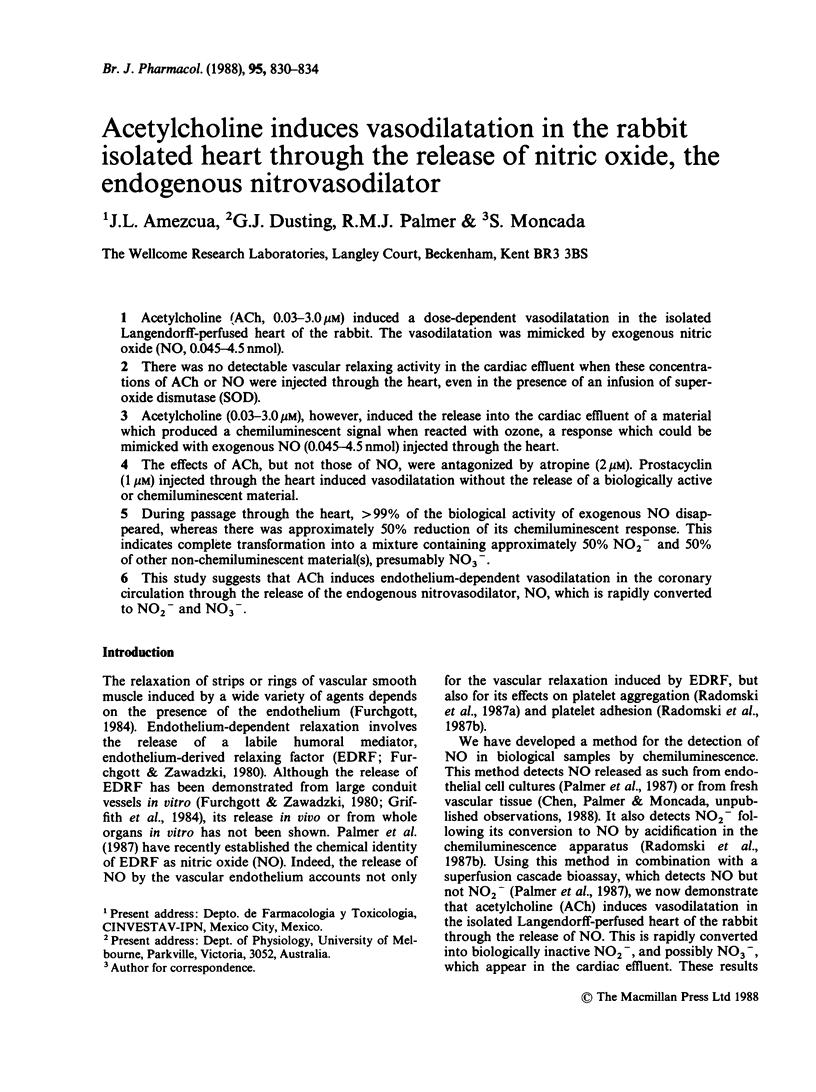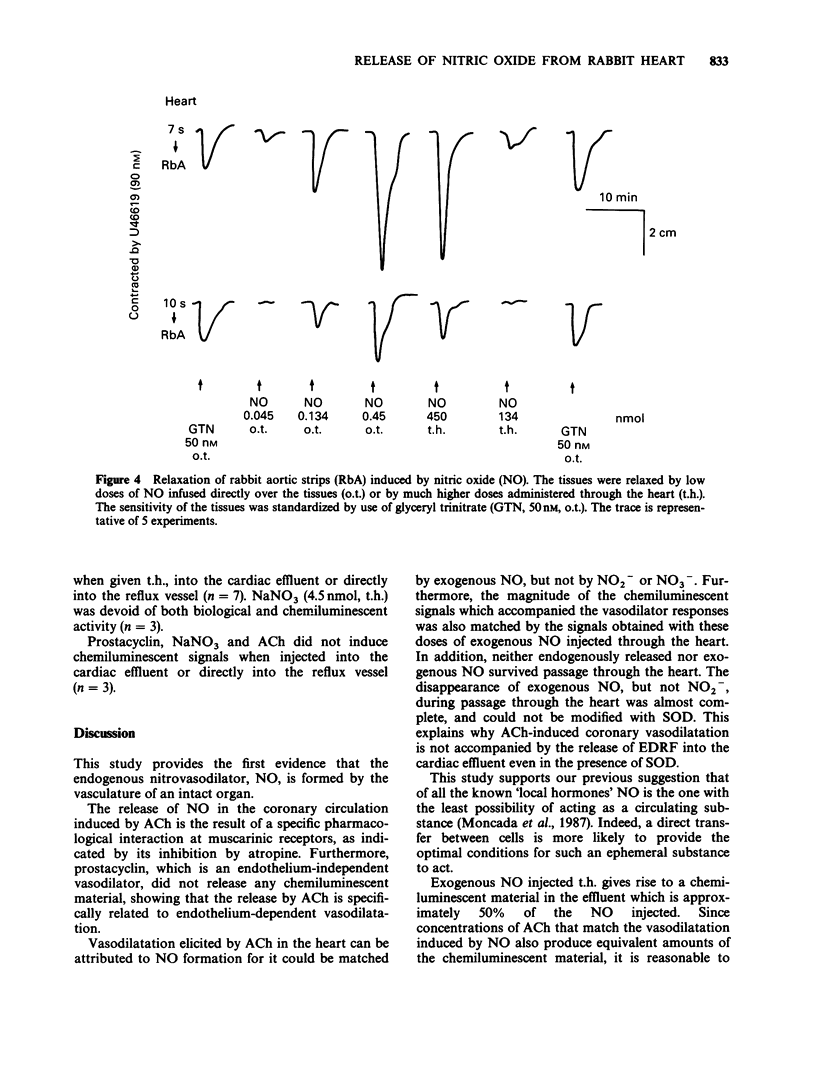Abstract
1. Acetylcholine (ACh, 0.03-3.0 microM) induced a dose-dependent vasodilatation in the isolated Langendorff-perfused heart of the rabbit. The vasodilatation was mimicked by exogenous nitric oxide (NO, 0.045-4.5 nmol). 2. There was no detectable vascular relaxing activity in the cardiac effluent when these concentrations of ACh or NO were injected through the heart, even in the presence of an infusion of superoxide dismutase (SOD). 3. Acetylcholine (0.03-3.0 microM), however, induced the release into the cardiac effluent of a material which produced a chemiluminescent signal when reacted with ozone, a response which could be mimicked with exogenous NO (0.045-4.5 nmol) injected through the heart. 4. The effects of ACh, but not those of NO, were antagonized by atropine (2 microM). Prostacyclin (1 microM) injected through the heart induced vasodilatation without the release of a biologically active or chemiluminescent material. 5. During passage through the heart, greater than 99% of the biological activity of exogenous NO disappeared, whereas there was approximately 50% reduction of its chemiluminescent response. This indicates complete transformation into a mixture containing approximately 50% NO2- and 50% of other non-chemiluminescent material(s), presumably NO3-. 6. This study suggests that ACh induces endothelium-dependent vasodilatation in the coronary circulation through the release of the endogenous nitrovasodilator, NO, which is rapidly converted to NO2- and NO3-.
Full text
PDF




Selected References
These references are in PubMed. This may not be the complete list of references from this article.
- Feelisch M., Noack E. A. Correlation between nitric oxide formation during degradation of organic nitrates and activation of guanylate cyclase. Eur J Pharmacol. 1987 Jul 2;139(1):19–30. doi: 10.1016/0014-2999(87)90493-6. [DOI] [PubMed] [Google Scholar]
- Furchgott R. F. The role of endothelium in the responses of vascular smooth muscle to drugs. Annu Rev Pharmacol Toxicol. 1984;24:175–197. doi: 10.1146/annurev.pa.24.040184.001135. [DOI] [PubMed] [Google Scholar]
- Furchgott R. F., Zawadzki J. V. The obligatory role of endothelial cells in the relaxation of arterial smooth muscle by acetylcholine. Nature. 1980 Nov 27;288(5789):373–376. doi: 10.1038/288373a0. [DOI] [PubMed] [Google Scholar]
- Griffith T. M., Edwards D. H., Lewis M. J., Newby A. C., Henderson A. H. The nature of endothelium-derived vascular relaxant factor. Nature. 1984 Apr 12;308(5960):645–647. doi: 10.1038/308645a0. [DOI] [PubMed] [Google Scholar]
- Gryglewski R. J., Moncada S., Palmer R. M. Bioassay of prostacyclin and endothelium-derived relaxing factor (EDRF) from porcine aortic endothelial cells. Br J Pharmacol. 1986 Apr;87(4):685–694. doi: 10.1111/j.1476-5381.1986.tb14586.x. [DOI] [PMC free article] [PubMed] [Google Scholar]
- Hackett J. G., Abboud F. M., Mark A. L., Schmid P. G., Heistad D. D. Coronary vascular responses to stimulation of chemoreceptors and baroreceptors: evidence for reflex activation of vagal cholinergic innervation. Circ Res. 1972 Jul;31(1):8–17. doi: 10.1161/01.res.31.1.8. [DOI] [PubMed] [Google Scholar]
- Palmer R. M., Ferrige A. G., Moncada S. Nitric oxide release accounts for the biological activity of endothelium-derived relaxing factor. Nature. 1987 Jun 11;327(6122):524–526. doi: 10.1038/327524a0. [DOI] [PubMed] [Google Scholar]
- Radomski M. W., Palmer R. M., Moncada S. Comparative pharmacology of endothelium-derived relaxing factor, nitric oxide and prostacyclin in platelets. Br J Pharmacol. 1987 Sep;92(1):181–187. doi: 10.1111/j.1476-5381.1987.tb11310.x. [DOI] [PMC free article] [PubMed] [Google Scholar]
- Radomski M. W., Palmer R. M., Moncada S. The role of nitric oxide and cGMP in platelet adhesion to vascular endothelium. Biochem Biophys Res Commun. 1987 Nov 13;148(3):1482–1489. doi: 10.1016/s0006-291x(87)80299-1. [DOI] [PubMed] [Google Scholar]
- Waldman S. A., Murad F. Cyclic GMP synthesis and function. Pharmacol Rev. 1987 Sep;39(3):163–196. [PubMed] [Google Scholar]


